As we’ve been reporting, prices for some retrofit primary EFIS systems have dropped to the sweet spot of around $5000 or less. This is thanks to a new regulatory certification process that sidesteps the pricey and time-consuming TSO process in favor of an STC. Aspen Avionics has populated the field with over 20,000 Evolution EFIS displays over a 10-year span and is the latest to offer a budget-based EFIS with the $4995 EFD1000 E5 Dual EFI.
But Aspen also offers other displays with more advanced features at higher price points, which muddies the buying decision. For this report we put the new E5 on our test bench to see how the feature set compares with other Evolution displays.
Enter Evolution e5 EFI
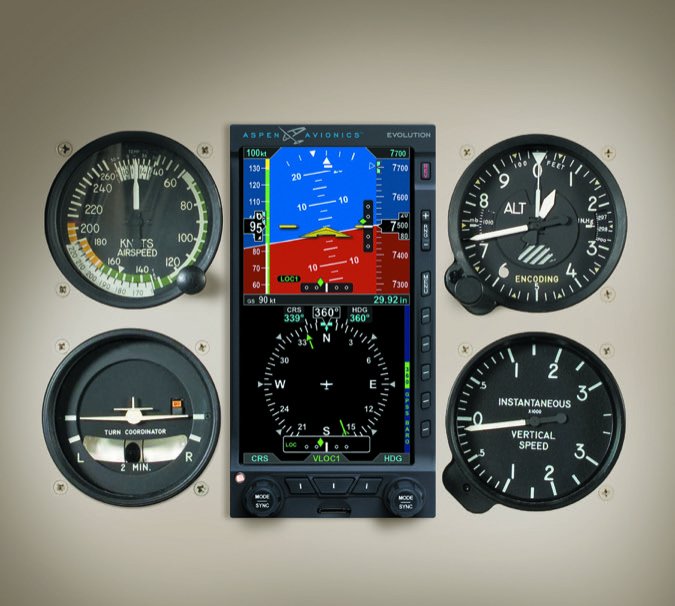
The non-TSO’d, STC-approved EFD1000 E5 EFI is Aspen’s answer to Garmin’s budget-based G5 EFIS displays. The E5 is approved under an AML-STC (approved model list supplemental type certificate), which blankets over 300 aircraft models. The E5 is still considered a major alteration and has the supporting paperwork for installation in type-certified aircraft despite not having a TSO.
Like every other Aspen Evolution PFD, the new E5 is several instruments in one. Unlike Garmin’s G5 series, which are two separate instruments (attitude and directional), Aspen’s E5 combines both an electronic DG and attitude display. Keeping with Aspen’s original design, the 4-inch-deep solid-state gyro can on the rear chassis slides into the existing attitude gyro panel cutout, while the bottom portion of the instrument simply sits over the DG cutout.
As we explain in the sidebar on page 6, the E5 has a full complement of flight instruments, but (aside from the attitude and heading) they aren’t for primary instrument replacement. That means the rest of the existing traditional instruments have to stay in the panel. The E5 also has basic GPS and raw nav course guidance, but there is no electronic HSI, although the E5 is fully IFR capable. There is no map display that’s standard on other Evolution PFD systems. Think basic utility.
As for sourcing the nav and GPS data for display, the E5 works with GPS navigators with Arinc 429 outputs, and with analog VHF nav radios (KX155, for one) when using Aspen’s optional analog converter unit (ACU), which is a remote box that converts analog inputs to digital outputs. This accessory adds $1000 to the $4995 base price. The converter is included with higher-end Evolution systems.
Unlike higher-end Aspen displays, the E5 won’t display synthetic vision or Aspen’s software-based angle of attack data. It will work with a variety of third-party autopilot systems, including S-TEC and also the TruTrak Vizion. For autopilot interfaces other than the digital TruTrak (which wires directly to the E5), the optional ACU is required.
Hardware, Feature Set
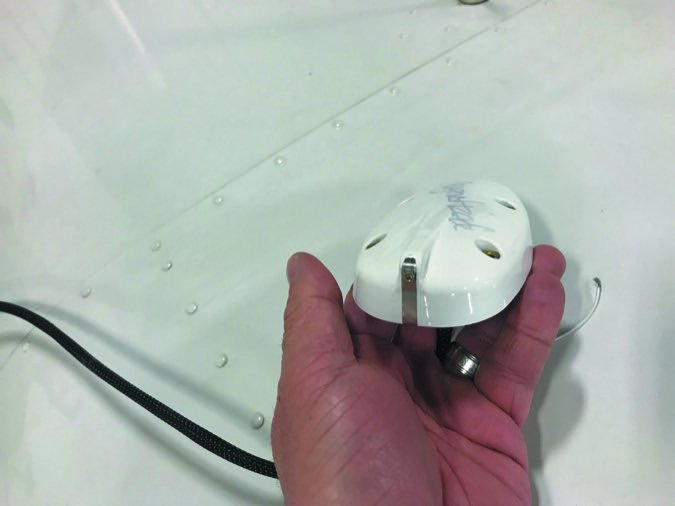
At first blush the E5 may look like the first-gen Evolution that Aspen has been selling since the beginning, but it’s quite different and uses Aspen’s new display and processor technology. If you’re used to those first-gen Evolution displays, even the entry-level E5’s display will look and perform better. With 32,768 colors, a 400 by 760 display resolution and high-intensity white LED backlighting, the 6.0-inch diagonal TFT active matrix LCD screen is noticeably more crisp and brighter than the first-gen units. Aspen said it designed the new display for better automatic dimming and even at the lowest brightness, the screen doesn’t lose its clarity. That’s important given its small size.
Aspen calls the E5 a Dual EFI (electronic flight instrument) because it’s really a dual instrument, replacing the traditional mechanical attitude indicator and directional gyro in one split display. The main electronics are contained in the unit, including a sensor board with solid-state AHRS (attitude and heading reference system), plus a digital ADC (air data computer) that’s also built into the gyro can. There’s also the MAP (main application processor) board, a CPU and IOP (input-output) board for communicating with remote systems, mainly GPS navigators and VHF nav radios.
The rear chassis has pneumatic connections for tying into the aircraft’s pitot and static systems (used for airspeed, altimetry and for other instrument resolutions). The rear chassis also houses a rechargeable (and field-replaceable) backup battery, a 44-pin D-Sub connector and a cooling fan.
Like every other Aspen PFD, the E5 comes with an RSM, or remote sensor module, which works together with the sensors inside the E5 for 3D magnetic heading and GPS computations. The RSM installs much like an external GPS antenna and its placement in an interference-free area on the top of the fuselage is critical for accurate heading resolution. The setup and initial configuration is also critical, so our advice is to find a shop that has experience installing other Aspen systems. That shouldn’t be difficult given Aspen’s large dealer network.
The primary input controls for the E5 are limited to two control knobs and the center button at the bottom of the display bezel. The knobs are used for setting the course and heading, plus additional bugs and altitude settings. The lower center button is for selecting the navigation sources for the electronic CDI and for entering and exiting the menu and for reversion or manual power control. The left and right buttons have no function on the E5. Five hot keys to the right of the instrument’s navigation display toggle various features on and off, including the built-in GPS steering. The function of each key is indicated by a label on the display to the left of each key.
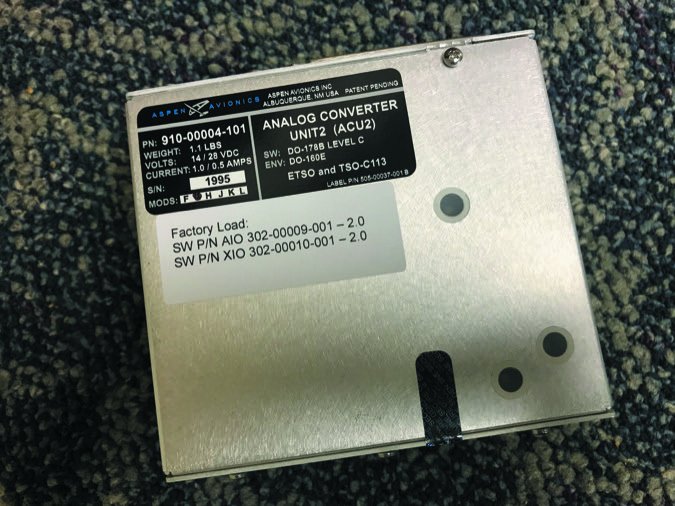
We think the E5 has an intuitive feature set that’s rather shallow compared to higher-end Aspen displays, and Aspen took a logical approach to the user experience. For instance, the left and right bezel knobs are designed to provide immediate operation, yet are designed with fail-safe so you don’t inadvertently cause an unwanted operation. For example, the first action of the knob wakes it up and changes the corresponding label from cyan to magenta. Additionally, the first click when the knob is turned (or the first press on the knob) wakes up the knob’s function. After 10 seconds of inactivity, the knob returns to its default setting.
The left knob’s primary function is for setting the E5’s course value, and it’s also used to bug an airspeed. The right knob is for the heading bug (HDG), editing the selected altitude field (ALT) and baro (BARO) setting. Successive presses of the right knob will cycle through HDG and ALT in a round-robin sequence. You also rotate the right knob to the left or right to decrease or increase the value of whatever is in the selected field. HDG is always the default setting for the right knob-the way it should be, given the frequency with which it’s used.
The E5 screen is divided into three parts: an upper attitude display, a lower navigation display and a data bar between the upper and lower halves. Unlike other Aspen displays, the E5 only has one page, so you’ll always view attitude and heading data.
The center button on the bottom of the display is for selecting/coupling the navigation source for the electronic CDI, which can be GPS1 or VLOC1, for example, depending on the external interface. Each press of this CDI nav source button selects the next available nav source, cycling through all available sources in a round-robin sequence. So there’s never any mistake as to which nav source you’re looking at, the currently coupled CDI nav source is displayed directly above the button. This is particularly critical when flying approaches and other precise procedures.
Three of the five keys along the lower right side of the EFI function as either single-action hot keys for frequently used commands or as menu keys when the E5’s menu has been activated. These hot key functions are accessible at any time, except when the main menu is active, and each hot key provides instant access to the assigned command.
Basic Attitude and Navigation Display
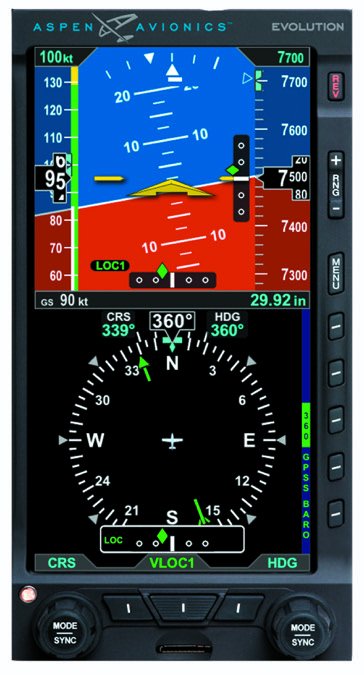
Pilots new to primary EFIS displays should transition easily to the E5 because the primary attitude data is a familiar presentation. The attitude portion of the instrument has a conventional blue over brown background with a white horizon line dividing the two areas. At extreme pitch attitudes (above 30 degrees nose up or below 25 degrees nose down), red unusual attitude recovery chevrons come into view, pointing toward the horizon or ground as applicable. At extreme pitch attitudes, some sky (blue) or ground (brown) will always be displayed to help maintain situational awareness, even though the horizon line may be off-scale. Slip/skid is indicated by the lateral position of the white rectangle under the roll pointer. One rectangle width is equivalent to one ball width of a conventional inclinometer.
The E5 has a data bar that visually separates the upper and lower halves of the display. GPS groundspeed (GS) and barometric pressure setting are shown in the data bar and when any of these values are either invalid or not available, the field is dashed. You’ll need a compatible GPS navigator to display GPS groundspeed.
The lower half of the EFI is the navigation display, which has 360-degree and ARC compass rose displays. There’s also the numeric display of the current magnetic heading, the selected heading and selected course. When connected to a GPS, there’s an onscreen ground track marker. Unlike higher-end Aspen displays, the E5 doesn’t have a traditional electronic HSI, but instead a basic CDI below the compass rose. The glideslope indicator (VDI) is placed up on the attitude display, as is the localizer (LDI) display.
Price It Out, First
While we think the E5 is a good value at $4995, we also think there’s a narrow market for it given Aspen’s other displays that have a more substantial feature set. The E5 can’t display Aspen’s synthetic vision or the angle-of-attack data, and it requires the $1000 ACU for most autopilot interfaces. For the difference in price, Aspen will, however, have an upgrade path for the E5, which turns it into a TSO’d 1000-series display that can support higher-end features including synthetic vision, AoA and onscreen wind data to name a few.
As for installation effort, that’s tough to nail because every aircraft is unique, but Aspen told us that 30 hours (minimum) of shop labor is a safe bet for the typical E5 installation. Remember, the interface requires a compatible IFR GPS navigator, and more than one navigator requires the installation of the optional ACU. In our estimation, even basic E5 installations might come in north of $7000.
As we go to press, Aspen is close to delivering the next-generation replacement for the Evolution Pro PFD with the Evolution MAX line. The MAX uses the new display and processor technology (the same that’s used in the E5), plus it also includes the ACU for advanced autopilot interfaces as standard. Existing Aspen displays can be upgraded to the MAX, which could be worth it for owners of legacy Aspen displays. The MAX display upgrade comes with a fresh two-year warranty.
During our E5 bench evaluation, we also powered up a new MAX display for comparison with the legacy Evolution Pro. We’ll do a separate article on these systems when they’re available this spring, but we like what we saw. Like the E5, the new MAX is a huge improvement in display performance. Like the E5, the MAX PFD has a GPS-aided AHRS for pitot static system failures, an audio panel interface, a faster processor, onscreen font and window enlargement, plus the requirement for backup flight instruments is eliminated when a PFD is paired with a MAX MFD1000. Aspen already has upgrade pricing in place on its webpage.
As for the entry-level E5, we think it’s a credible and affordable product to compete with Garmin’s G5 if you can live with a no-frills feature set.
Backing Up An Aspen Suite
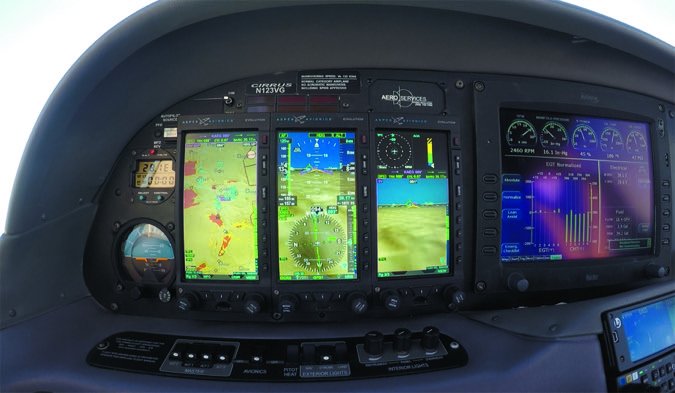
No matter which Aspen you chose, you’ll need to consider a backup strategy. In the case of the entry-level E5, you might end up retaining the existing attitude indicator even though the STC doesn’t require one. That’s a drastic shift from previous Aspen upgrades, particularly ones that include multiple TSO’d screens like the one pictured in the Cirrus panel here. Even though there is plenty of reversionary capacity (the right display can function as a PFD if the main PFD in the center goes down), plus a standby remote battery that powers the display if the electrical system tanks, the installation still requires a backup attitude indicator. That’s not the case with the non-TSO’d EFD1000 E5.
Since the E5 was certified (via an AML-STC) using new ASTM standards, the typical installation doesn’t require a backup attitude indicator as required by old regulations. As we explained, the E5 does require standalone airspeed, altimeter and turn coordinator instruments. But the STC does allow removing the vacuum system. If that’s your goal, and you aren’t comfortable with the E5’s single attitude source, you’ll have to buy an electric (or electronic) backup AI. Yes, Garmin’s G5 EFIS display is a logical choice for backing up the E5, but Garmin’s STC only permits the G5 to be installed as the primary AI, or for backing up other Garmin displays, including the TXi PFD.
Since the E5 uses pitot and static pressure input as part of the AHRS attitude calculations, loss or corruption of the pitot or static pressure (perhaps an iced up pitot tube) can influence the accuracy of the displayed attitude data. That’s a bugaboo with other legacy Aspen displays, and a compromised pitot reference can result in the loss of all primary flight data-even attitude. That’s not the case with the E5 when it’s connected to a compatible IFR GPS navigator, including a Garmin GNS or GTN. That’s because the E5 can use GPS groundspeed instead of indicated airspeed as part of its overall AHRS solution.
In that case, the E5 will continue to display attitude and heading data and will display an “attitude degraded” message on the screen to prompt the pilot to turn on the pitot heat. When the system detects the pitot obstruction is clear, the degraded message goes away and the AHRS resets. Aspen users have waited years for this solution and it’s built into the E5 and the new MAX.
Contact www.aspenavionics.com and at 888-992-7736.

